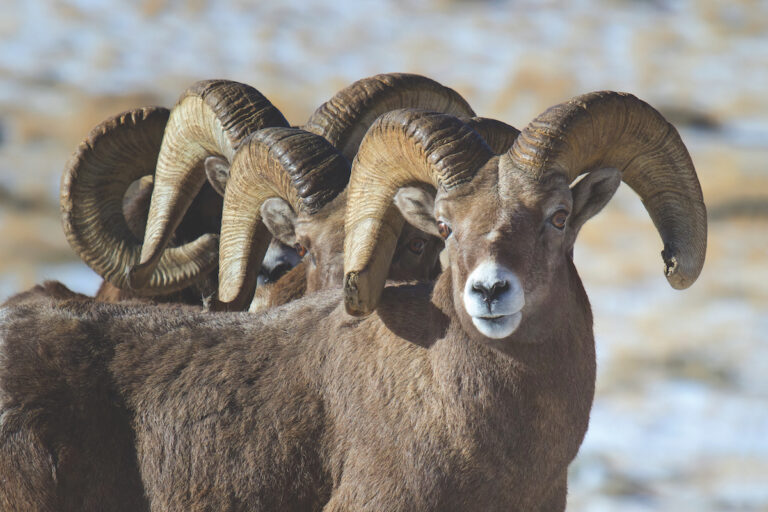Backcountry skiers and environmentalists work to balance sheep habitat needs
Winter/Spring 22-23
Written By: Emmie Gocke
| Images: Mark Gocke

In the words of legendary outdoorsman Jack O’Connor, “The wild ram embodies the mystery and magic of the mountains, the rocky canyons, the snowy peaks, the sweet, clean air of the high places, and the sense of being alone on the top of the world with the wild sheep themselves.”
For thousands of years, bighorn sheep have spent their lives among the steep faces of the Tetons that also call to climbers, alpinists, and backcountry skiers. Over the past century, the delicate balance humans hold in the ecosystem has shifted, and increased human pressure threatens the existence of the iconic Teton bighorn sheep herd.
The human relationship with bighorn sheep in the Tetons stretches back millennia, initiating with the Tukudika Shoshone people, or “Mountain Sheepeaters,” and their ancestors. As the name suggests, Tukudika lifeways are deeply entwined with bighorn sheep and the dramatic mountain terrain they inhabit, including the Tetons. The sheep provided their most common source of game meat, thick buckskin hides for clothing, and horns that produced the strongest bows of the age. Prehistoric hunting camps have been identified throughout the Teton Range including Fox Creek Pass on the Teton Crest Trail, and Ranger Peak overlooking Jackson Lake. Projectile points at these sites indicate Tukudika were hunting bighorn sheep in the Tetons over a span of 6,000 years, although the relationship is estimated to be much older. Even when the arrival of the horse offered many Shoshone easier hunting on the plains, the Tukudika returned seasonally to the high country of the Tetons to continue their ancient pursuit of the bighorns.
As Euro-American expansion and colonization marched west in the 1800s, the Teton bighorn sheep herd held no immunity to the destruction of unchecked hunting, livestock competition, foreign diseases, and winter range reduction that decimated wildlife populations across the region. In 1872, a geologist of the Hayden expedition reported “abundant tracks of mountain sheep were found as high as the saddle south of Mount Hayden (Grand Teton),” but the rapid human settlement within the bighorn winter range in the Jackson Hole valley in the 1880s led to a precipitous decline in numbers. By the 1920s, bighorns in the Tetons were “rarely seen except at the extreme north end of the range, where a band of less than a hundred survivors” remained.
By the 1950s, the remnants of the Teton sheep herd had ceased migrating to their low-elevation winter range altogether, opting to weather extreme winter conditions on the high peaks of the Tetons rather than navigate the expanding human settlements below. Over the intervening decades, a small population of genetically unique bighorn sheep have clung to their ancient home range in the Teton high country, scouring the isolated windswept ridges for exposed grasses and lichens to sustain them through bitter winds and subzero temperatures.
Over the past several years, backcountry skiing and ski mountaineering in the Tetons has exploded in popularity, and human pressures during the harshest winter months are extending to the remote crags the sheep once guarded in solitude. A 2014 study by Aly Courtemanch, a Wyoming Game and Fish biologist based in Jackson, found that the Teton bighorns have lost up to 30 percent of suitable winter habitat due to human displacement, largely from backcountry skiers. Since then, winter recreation in the park has only increased, and in turn the human impact felt by the sheep as they tough it out in one of the most extreme environments in the world.
Although some winter closures of sheep habitat in the Tetons have been in place since the ’90s, they are minimal and often unknown and unheeded. If the iconic sheep herd and our ancient human relationship to them is to persist, and ultimately thrive once more in the Tetons, we must explore ways to balance sheep habitat needs, and our unparalleled winter backcountry experiences that inspire the extraordinary relationship with the Tetons we cherish.
The Jackson Hole community has risen to the challenge. Over the past two years, the Teton Sheep Working Group has seen unprecedented participation at a series of public information and input sessions to design potential closures that would give the sheep the greatest chance of survival without eliminating the iconic ski mountaineering of the Tetons. Though some recreationists argue that there is no evidence closures will improve sheep numbers, most meeting participants favor compromise.
In a recent documentary about the issue called “Denizens of the Steep,” professional ski mountaineer Kim Havell emphasizes the importance of the sheep to preserving wild places. “We all want to ski in these remarkable places so by no means is my approach that we shouldn’t go skiing,” Havell says. “But I think doing it with an ability to compromise, adjust, and pay attention is what will keep these things intact.” In recognizing the value of wild sheep to the Teton landscape, we may continue an ancient human connection to these lifelong tenants of the mountains.

